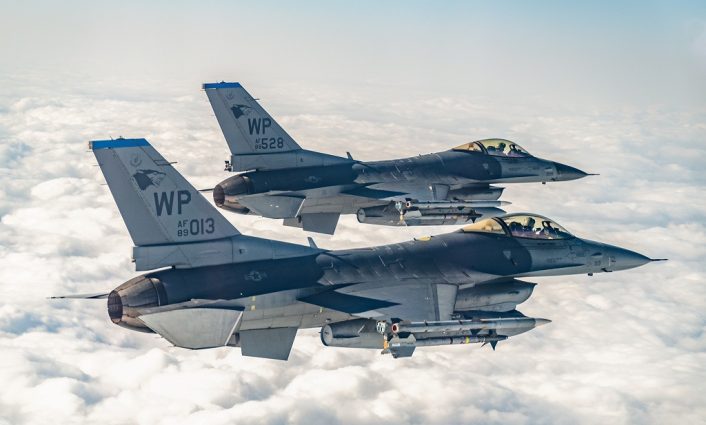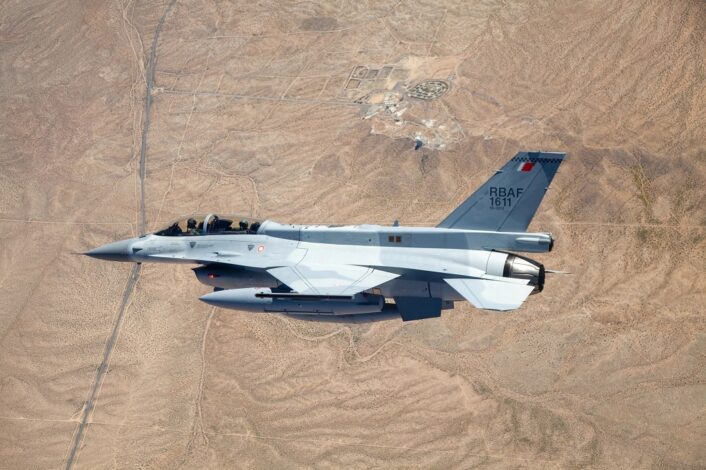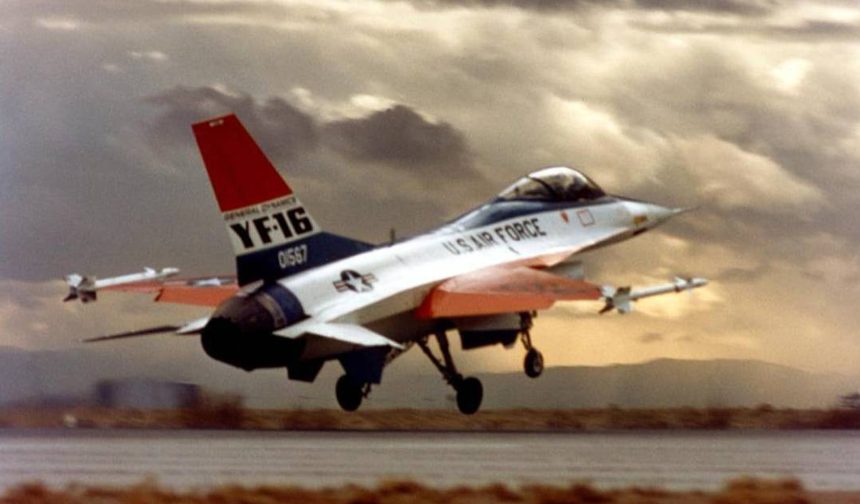On Jan. 20, 1974, the YF-16 No.1 flew for the first time, although it wasn’t planned. Here is what happened over the next 50 years.
Today, Jan. 20, 2024, marks half a century since the first flight of one of the world’s most popular and most recognizable fighter jets, the F-16 Fighting Falcon. The “Viper”, as the F-16 is nicknamed by its crews, grew through the years to become the world’s most numerous fighters in service today, with an active fleet of more than 2,100 aircraft in 25 countries, or 2,800 if we consider also training aircraft and non-combat roles.
The F-16 has been the backbone of the U.S. Air Force, with 935 aircraft in service which account for 50% of the service’s fighter inventory. The F-16 has flown an estimated 19.5 million flight hours and at least 13 million sorties. About 4,600 F-16 have been built and the production line is still active, with a backlog of 140 still to be produced. Today’s Viper, however, is a totally different machine, the result of 50 years of evolution that brought the F-16 from the initial light-weight day fighter project to the current multi-role fighter jet.
The birth of the F-16
Colonel John Boyd is considered the father of the F-16, as his innovative ideas led to the program which resulted in the F-16. Based on his experience in combat and as instructor, Boyd called for a small, lightweight aircraft that could maneuver with the minimum possible energy loss and which also incorporated an increased thrust-to-weight ratio.
In 1969 the Department of Defense funded General Dynamics and Northrop to study design concepts for the Advanced Day Fighter program, resulting in the YF-16 and YF-17 prototypes. The GD team set out to trade excess weight and heavy payloads for speed and maneuverability, to develop a simple, inexpensive fighter that “would fly so fast and turn so quickly that adversaries would be unable to strike it with either missiles or machine gun fire”.
The F-16 design team translated those ideas into the most advanced combat aircraft of its day, making great use of new technologies. A smooth blended-wing body provided extra lift and control, while a critical fly-by-wire system kept the design stable and increased its agility; the aircraft also had the ejection seat tilted back 30°, side-mounted control stick, head-up display and bubble canopy which improved pilot survivability as well as visibility and control.
Jan. 20, 1974, test pilot Phil Oestricher brought the YF-16 No.1 on the runway at Edwards Air Force Base, California, for a high-speed taxi test up to 135 knots to check-out the pre-takeoff handling characteristics before the first flight, scheduled to happen two weeks later. Things however went differently, as Oestricher was forced to lift off in an effort to save the aircraft, after a series of large oscillations caused the aircraft to bounce multiple times on the main landing gear and strike the runway with the right horizontal stabilizer.
“We’d progressively taxied the airplane faster and faster and wanted to get a better idea of how it handled,” explained Oestricher. “Few people know this, but we actually intended to lift the airplane off the ground that day. Our intention was to move the throttle to military power for a few seconds and let the main gear come up a couple of feet while we went down the runway.”
“We encountered two problems,” Oestricher continued. “First, the roll control was too sensitive, too much roll rate as a function of stick force. Second, the exhaust nozzle control for the prototype was wired incorrectly. You had to be on the ground for the nozzle to be wide open, so as soon as you took the weight off the wheels, the nozzle closed and essentially doubled the thrust at idle.”
To avoid losing the aircraft, Oestricher increased the power and took off, safely touching down six minutes later after flying a wide pattern around the runway. Engineers solved the control problem by that evening, while the repairs took a bit longer but allowed to proceed with the first flight as scheduled two weeks later, on Feb. 2.
The next year, on Jan. 13, 1975, the U.S. Air Force declared the YF-16 as the winner of the competition because of its lower operating costs, greater range and better maneuver performance than that of the YF-17, as well as its use of the same P&W F100 engine of the F-15 Eagle. Few months later, the YF-17 went on to win the similar competition and to be further developed in the F-18 Hornet.
The YF-16 was also further developed, with the first F-16A flying on Dec. 8, 1976. The Air Force planned to order up to 1,400 aircraft, with the first one entering operational service at Hill AFB, Utah, on Oct. 1, 1980. In the meanwhile, in 1975 Belgium, Denmark, the Netherlands and Norway ordered 348 aircraft as European Participation Air Forces, leading to the production of two European production lines.
Continuous evolution
The F-16 continued to be upgraded through the years with different construction blocks for the initial single seat F-16A and twin seat F-16B. These variants include the Block 1, 5, 10, 15, and 20, of which the Block 15 was the first major modification, including new larger horizontal stabilizers. The next major upgrade was the Block 25, which prompted the change of designation in F-16C/D, with the first F-16C performing the maiden flight on Jun. 19, 1984.

The F-16C featured many improvements, such as the APG-68 radar, multi-function displays, wide-angle holographic Head-Up Display, AGM-65D Maverick and AIM-120A AMRAAM, new fire control and stores management computers. Externally the Viper was almost unchanged, but it now had improved Beyond Visual Range and nighttime/precision strike capabilities.
Another big change followed with the Alternative Fighter Engine program, with the Air Force splitting engine orders between Pratt & Whitney and General Electric. This led in 1986 to the Block 30 with the GE F110 engine and the Block 32 with the P&W F100 engine, with the former requiring a larger inlet as it provided more thrust and thus required a larger air flow intake. This classification of Blocks based on engines is valid still today.
1988 saw the rollout of the Block 40/42, also known as Night Falcon because of its improved night/all weather capabilities. This Block introduced the LANTIRN navigation and targeting pods and the associated holographic HUD (allowing the use of Paveway laser guided bombs), GPS, improved APG-68V(5) radar, digital flight controls and automatic terrain following. The F-16s at Aviano Air Base, Italy, were further modified, becoming the first to employ in 1995 Night Vision Goggles and an Improved Data Modem.
In 1991 the first Block 50/52 rolled out of the factory, including yet again many new improvements for radar, countermeasures and avionics, as well as the capability to employ the then new Joint Direct Attack Munitions and Joint Stand-Off Weapons. A part of them were modified for the “Wild Weasel” role, allowing the F-16 to perform Suppression of Enemy Air Defenses with the AGM-88 HARM and the ASQ-213 HTS (HARM Targeting System).
For some time, this was the last production Block, although it was continuously updated becoming the Block 50/52+. The aircraft already in service were also upgraded, with the F-16A/B fleets of the EPAF upgraded to a standard similar to the Block 50/52 thanks to the Mid-Life Update and, for the US aircraft, the Common Configuration Implementation Program which delivered the first aircraft in 2002.
In the meanwhile, the Block 60 was also being developed for the United Arab Emirates. The exotic variant was initially planned to become a delta wing aircraft, although the plan later changed. The aircraft featured Conformal Fuel Tanks, an Internal FLIR and Targeting System, the APG-80 Active Electronically Scanned Array radar, an Airborne Self-Protection Jammer and many avionics improvements.

The F-16 in 2024 and beyond
Today we have a new variant, the Block 70/72 Viper, which is being produced as both newly built aircraft, with the maiden flight of the first new F-16 in 2023, and as upgrade of aircraft already in service, with the first delivery in 2019. The F-16 Block 70/72 are the most advanced production Vipers featuring the APG-83 AESA radar, a new Center Pedestal Display, Link 16 datalink, full Night Vision Imaging System compatibility, a new Embedded GPS/INS and Automatic Ground Collision Avoidance System.
The production of the new variant has been moved to Greenville, South Carolina, leaving the historic F-16 production site in Fort Worth, Texas, which is now focused on the F-35 Lightning II. So far, six countries have selected the F-16 Block 70/72 and Lockheed Martin says that there is a current new production backlog of 135 jets.
While many of the older airframe are reaching their structural life limit and are being retired, many are finding new uses, such as the Air National Guard F-16 Block 30 jets which are now flying the Aggressor mission with the Navy or the former Israeli F-16 which are flying as Red Air during training missions of various Air Force units.
Even with more modern aircraft becoming operational, the F-16 is set to keep flying well into the 2050s with many air forces around the world. In fact, although the F-16 is being replaced by its heir, the F-35, they will continue to share the skies for a long time as many countries are still buying F-16s to replace their old aircraft.









